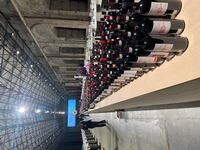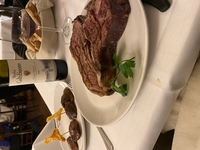 and 2022 vintages over two days reminded me why Chianti Classico is, justifiably, so popular around the world. The setting for the tastings was the venerable — and quite enormous — train station in Florence where every year the Consorzio Vino Chianti Classico (the organization that represents producers) presents some 700-plus samples of Chianti Classico spanning several recent vintages and all quality levels. The three vintages — all currently on the market — or in the case of the 2022s, soon to be — are wonderfully individuated and provide something for everyone. The riper 2020s in general reflect the warmer growing season and are fleshier. The sleek 2021s, a product of a year with cooler summer nights that allowed grapes to hold their acidity, are racy, while the charming 2022s, with their youthful vigor and angularity, fall somewhere in-between.
and 2022 vintages over two days reminded me why Chianti Classico is, justifiably, so popular around the world. The setting for the tastings was the venerable — and quite enormous — train station in Florence where every year the Consorzio Vino Chianti Classico (the organization that represents producers) presents some 700-plus samples of Chianti Classico spanning several recent vintages and all quality levels. The three vintages — all currently on the market — or in the case of the 2022s, soon to be — are wonderfully individuated and provide something for everyone. The riper 2020s in general reflect the warmer growing season and are fleshier. The sleek 2021s, a product of a year with cooler summer nights that allowed grapes to hold their acidity, are racy, while the charming 2022s, with their youthful vigor and angularity, fall somewhere in-between.The 2020 and 2021 Chianti Classico, as a pair of vintages, remind me of the 2015 and 2016 with the former being lusher and the latter fresher and edgier. Drinking — as opposed to tasting — Chianti Classico in restaurants in Florence confirmed just how well they are suited for food.
Chianti Classico has three quality tiers, Annata (literally, the year), Riserva, and Gran Selezione, which help the consumer answer the oft asked — and sadly oft unanswered — question: When might the wine be ready to drink?
The label of the Annata wines will not feature the word Annata, but merely the vintage. These wines have flavor that belies their weight. Although ready to drink upon release, there’s no rush to drink them immediately. I’m still enjoying many Annata from the stellar 2016 vintage. These lively mid-weight reds combine fruitiness and savory notes balanced by mild tannins and bright acidity. Producers generally understand that these wines are not trying to be “important,” so they don’t oversize them, or imbue them with intrusive tannins or oaky flavors from winemaking manipulations.
Chianti Classico Riservas are more serious and will always sport Riserva on the label. Winemakers typically select their best grapes for Riservas, which by law, must be aged for an additional year (two compared to one for Annata) before release. As such, the wines destined for the Riserva category, must have more “oomph” to withstand additional barrel aging without being thrown out of balance by the wood influences. They typically need a few years in the bottle to show their complexity and stature.
Considering that over 300 hundred years ago, Grand Duke Cosimo III de’ Medici shined a spotlight on what is now Chianti Classico with his 1716 bando (proclamation) identifying and codifying the area as a high-quality wine region, (kind of a forerunner of the DOC [Denominazione Origine Controllata] classification), Gran Selezione is a relatively new category, only about a decade old. It was created to highlight the top wines of Chianti Classico. To be labeled Gran Selezione, the wines must come from the producers’ own grapes — no purchased grapes allowed — and must be aged for 30 months, as opposed to two years for the Riservas. Sangiovese must comprise a larger proportion of the blend, 90 percent compared to 80 percent for Riserva and Annata. The label of Gran Selezione will be allowed to identify one of the recently delimited 11 subregions of Chianti Classico (UGAs, Unità Geografica Aggiuntive, literally additional geographic unit) from which the grapes came. Wines in the Gran Selezione category should enrobe all the power and charms of Riservas in a silky, suave texture. Think cashmere rather than lambswool. The Gran Selezione are typically more elegant and complex, with more subtleties, but not necessarily more power than the Riservas. That said, like Riservas, Gran Selezione need additional bottle aging to blossom, so they too are good candidates for cellaring.
Remember, Chianti Classico is itself a sub-zone of the greater Chianti region, which encompasses a large area surrounding Florence and Siena in Tuscany. It’s the most widely recognized sub-zone thanks to the Galo Nero or Black Rooster logo that appears on the neck of each bottle. (For completeness, the other seven are Chianti Rùfina, Chianti Colli Senesi, Chianti Colli Fiorentini, Chianti Montalbano, Chianti Colli Aretini, Chianti Montespertoli, and Chianti Colline Pisane.)
A word about UGAs. The push in Chianti Classico, as with all fine wine regions, is towards greater specificity in identifying the source of grapes. Enter the UGAs, eleven sub-regions within Chianti Classico whose basic environment—terroir, to use the French concept — imparts a uniqueness or identity to the wines. Or so the theory goes.
The problem in Chianti Classico is that, apart from Lamole and Montefioralle, each UGA is large and has an enormous diversity of soil, elevation, and exposures that makes it difficult to define the character of each. Add to that, the tremendous impact of the producers’ style of winemaking can overwhelm the distinctiveness of a UGA, even if there is one. That said, the UGAs, in general, can give consumers additional information about the style of the wines — racier wines from the cooler, higher altitude Lamole are different from the riper ones coming from sun-drenched Panzano. For completeness and because consumers will start to see the names on labels, the eleven UGAs are: San Casciano, Greve, Montefioralle, San Donato in Poggio, Panzano, Lamole, Radda, Castellina, Gaiole, Vagliagli, and Castelnuovo Berardenga.
Ironically, although the Consorzio of Chianti Classico is adamant, as they should be, about emphasizing the Classico portion of the name and reminding even journalists who should know better, not to abbreviate Chianti Classico to Chianti, even many restaurants in Florence don’t make the distinction. On more than one restaurant’s wine list Chianti Classico, Chianti Rufina, and just plain Chianti were all lumped together. So, Reader, my advice is to learn about the sub-zones and UGAs, but most importantly remember my mantra: producer, producer, producer.
That said, here are some specific recommendations:
 From the 2020 vintage, I Fabbri’s fresh and lively “Terra di Lamole” delivers a firmer style of Chianti Classico with an impeccable balance of dark cherry-like fruitiness and minerality. (92 points; $28). In the same vein, the incredibly long 2020 Chianti Classico from Azienda Storica Castellinuzza, owned by the Cinuzzi family since the 1400s, conveys a touch of fresh red cherry-like notes to accompany its firm stoney texture. (91 Points; $25). The suave 2020 from Badia a Coltibuono is ideal with a simply grilled steak. (91 Points; $24).
From the 2020 vintage, I Fabbri’s fresh and lively “Terra di Lamole” delivers a firmer style of Chianti Classico with an impeccable balance of dark cherry-like fruitiness and minerality. (92 points; $28). In the same vein, the incredibly long 2020 Chianti Classico from Azienda Storica Castellinuzza, owned by the Cinuzzi family since the 1400s, conveys a touch of fresh red cherry-like notes to accompany its firm stoney texture. (91 Points; $25). The suave 2020 from Badia a Coltibuono is ideal with a simply grilled steak. (91 Points; $24).
These two widely available Chianti Classico Riservas from the 2020 vintage are entering their drinking window. The gorgeous Principe Corsini-Villa Le Corti, “Cortevecchia” Chianti Classico Riserva combines a bit of fruitiness, herbal nuances and minerality into a mid-weight and graceful frame. (94 Points; $36). The denser and more robust Querciabella 2020 Chianti Classico Riserva impresses with suave tannins and a long and refined finish (94 Points, $48).
Now let’s turn to the 2021 Annata. Bright acidity balances the riper style coming from the 2021 Castello di Radda Chianti Classico. A captivating earthy savory aspect just expands its appeal (93 Points; $25).
Fattoria le Masse’s sleek and poised 2021 Chianti Classico, made exclusively from Sangiovese, shows the stature of that grape in the right hands. Elegant and refined, le Masse’s needs a few years to unwind, so find a space in your cellar for this annata (95 Points; $45).
Fontodi excelled with two 2021s. Their savory Chianti Classico conveys a dark cherry-like power without heaviness (93 Points, $45), while Fontodi’s spellbinding Chianti Classico Filetta di Lamole — certainly one of the standouts of the vintage — provides a multidimensional excitement coupled with finesse. It reminds us that a great wine need not be heavy and overwhelming (96 Points; $41).
The ever-consistent Isole e Olena produced an alluring 2021 Chianti Classico redolent of darker fruit and a captivating hint of tar (94 Points, $35). Although all these 2021s will improve with time in the bottle, especially le Masse’s, they still provide enormous enjoyment now.
Similarly, I was struck by how beautifully the 2021 Chianti Classico Riservas were showing. They, like the 2021 Annata releases, will improve with more bottle age, but they deliver plenty of pleasure now.
As always, the gorgeous aromatics of the harmonious 2021 Castellare de Castellina Chianti Classico Riserva predicted delights to follow. And they did. Savory, fruity, and nuanced, it is the epitome of a Riserva (94 Points; $34). As an aside, I’ve already seen the more straightforward 2022 Castellare de Castellina Annata on retailer’s shelves. Bright and balanced, it’s a delight for current drinking (92 Points, $26).
With fine tannins, the lush and suave 2021 Castello di Volpaia Chianti Classico Riserva would be a joy to match with a grilled steak this summer (93 Points, $46).
And don’t overlook the graceful 2021 Riecine Chianti Classico Riserva lest you miss this mid-weight marvel of spice and fruit wrapped in fine unobtrusive tannins (93 Points, $50).
A quartet of 2019 Chianti Classico Gran Selezione shows the heights that wines from this DOCG can reach. Despite of, or perhaps because of, its mid-weight size, the 2019 I Fabbri Chianti Classico Gran Selezione commands a presence. It’s delicious now (95 Points, $59).
The suave and stunning 2019 Gran Selezione of Lamole di Lamole comes from the single vineyard, Vigneto di Campolungo and is another mid-weight beauty that wows you with grace and refinement rather than shear power (95 Points, $50).
The captivating 2019 Gran Selezione from Monteraponi dazzles with a darker fruit profile and a hint of minerals wrapped in glossy tannins (96 Points; price n/a).
And last, but by no means least, Querciabella’s 2019 Gran Selezione bursts from the glass, combining power and refinement (96 Points; $260 for the 2018).
The above recommendations represent only a smattering of the hundreds of notable Chianti Classico from these three vintages. I could have easily listed a hundred more. So, my advice is to dive in and explore for yourself the differences between the lusher 2020s and the racier 2021s and then see how they compare to the 2022s when they become more available. And answer the question for yourself: Do the Riserva and Gran Selezione give you more enjoyment than the Annata, considering their higher price?
A recent advertisement from one of New York’s top wine retailers, Flatiron Wines & Spirits, reminds readers of the ridiculously affordable pricing for Chianti Classico: Principe Corsini-Villa Le Corti 2016 or 2021, both gorgeous vintages, for all of $24 each.
E-mail me your thoughts about Chianti Classico at Michael.Apstein1@gmail.com and follow me on Twitter and Instagram @MichaelApstein.
